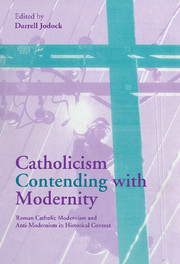 Catholicism Contending with Modernity
Catholicism Contending with Modernity Book contents
- Frontmatter
- Contents
- List of contributors
- Acknowledgments
- List of abbreviations
- Note on the text
- Introduction I: The Modernist crisis
- Introduction II: The Modernists and the anti-Modernists
- PART I THE LATE NINETEENTH-CENTURY SETTING OF MODERNISM AND ANTI-MODERNISM
- 1 Vatican foreign policy and the origins of Modernism
- 2 Catholic anti-Modernism: the ecclesial setting
- 3 Theological and philosophical Modernism
- PART II MAURICE BLONDEL AND ALFRED LOISY IN FRANCE
- PART III FRIEDRICH VON HÜGEL AND MAUDE PETRE IN ENGLAND
- PART IV SOCIAL MODERNISM AND ANTI-MODERNISM IN FRANCE
- Conclusion
- Index
3 - Theological and philosophical Modernism
Published online by Cambridge University Press: 30 October 2009
- Frontmatter
- Contents
- List of contributors
- Acknowledgments
- List of abbreviations
- Note on the text
- Introduction I: The Modernist crisis
- Introduction II: The Modernists and the anti-Modernists
- PART I THE LATE NINETEENTH-CENTURY SETTING OF MODERNISM AND ANTI-MODERNISM
- 1 Vatican foreign policy and the origins of Modernism
- 2 Catholic anti-Modernism: the ecclesial setting
- 3 Theological and philosophical Modernism
- PART II MAURICE BLONDEL AND ALFRED LOISY IN FRANCE
- PART III FRIEDRICH VON HÜGEL AND MAUDE PETRE IN ENGLAND
- PART IV SOCIAL MODERNISM AND ANTI-MODERNISM IN FRANCE
- Conclusion
- Index
Summary
“In a higher world it is otherwise; but here below to live is to change, and to be perfect is to have changed often.” John Henry Newman's celebrated dictum still has the power to startle, coming as it does from a dedicated opponent of liberal Christianity. Newman's conception of Christianity as a “great idea” enabled him to contemplate its interaction with history as a living thing, constantly changing in order to retain its identity. The daring model of Christianity as an “idea,” that is, an impression made upon the imagination, proved incomprehensible to the neo-scholastic mind, which treated the imagination as vastly inferior to the discursive intellect and which saw no reason at all to wrestle with the seemingly intractable problem of how doctrine could preserve its identity as it passed through the cultural vagaries of historical existence. Neo-scholastic ultramontanism saw itself as charged with the custodianship of a fixed and unchangeable deposit; it described the philosophy on which it drew for cognitive self-expression as perennis – that is, valid in and applicable to all ages. The conflict between the concept of Christian doctrines as immutable and perennially valid, on the one hand, and, on the other, as culturally limited expressions of truths which are antecedent to their formulation constitutes the theological core of the Modernist crisis which occurred in the Roman Catholic Church between c. 1890 and 1914.
- Type
- Chapter
- Information
- Catholicism Contending with ModernityRoman Catholic Modernism and Anti-Modernism in Historical Context, pp. 88 - 112Publisher: Cambridge University PressPrint publication year: 2000
- 1
- Cited by


